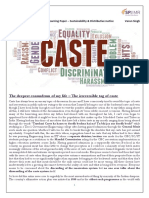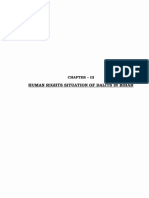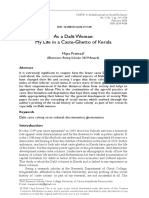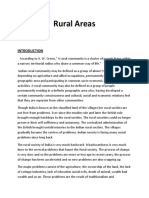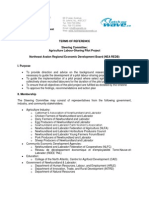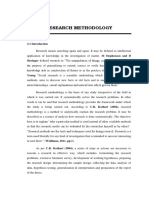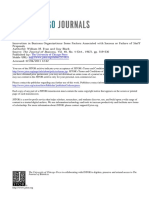Review Of: Rural Poverty in Punjab: A Case Study of Village Shergarh
Review Of: Rural Poverty in Punjab: A Case Study of Village Shergarh
Uploaded by
Mangesh PandeyOriginal Description:
Original Title
Copyright
Available Formats
Share this document
Did you find this document useful?
Is this content inappropriate?
Report this DocumentCopyright:
Available Formats
Review Of: Rural Poverty in Punjab: A Case Study of Village Shergarh
Review Of: Rural Poverty in Punjab: A Case Study of Village Shergarh
Uploaded by
Mangesh PandeyCopyright:
Available Formats
SOCIAL HAZARDS OF DEVELOPMENT CIA III
REVIEW OF: ‘RURAL POVERTY IN PUNJAB:
A CASE STUDY OF VILLAGE ‘SHERGARH
Abstract By: Bismah Rahman, Abu Saadat
Review of the case study
This is a case study by Dr Manjit Sharma, about poverty in a village named Shergarh in the
Bhatinda district of Punjab. Being a relatively better-performing state, all the 15 poorest
households that are selected as samples for the research had self-owned houses, almost 3 meals a
day etc. But poverty is visible in terms of health, education, family assets etc. The family size of
the sample households is also taken understudy to understand the dependency of the family on the
earner and the demography of the sample. Assets that are studied for the research are the quality
of the houses, that is, availability of kitchen, bathroom, proper drainage system, toilets, handpump,
electricity, animals, land owned and private transport (by-cycle). Education level in these
households was not very good either for 60% of the households, the family head was illiterate.
40% of children in the family were not going to schools. 53.33% of the households had members
addicted to alcohol, smoking or any other substance abuse. He also talks about the type of
consumption and uses the calorie method to understand poverty.
The author has used such measures to study poverty in the village of Shergarh. By looking at the
area of focus we can say that the author shares the school of thought of Amartya Sen while looking
at poverty. Addressing the absolute poverty in terms of education and health of the households
shows a better picture to analyse the poverty in a region. One of the things that I feel is a problem
in the study is that the sample is too small for a village and also the process of selecting the sample
is a little complicated if not absurd. He divided the village into 3 caste groups and then asked the
5 most knowledgeable people from each caste group to pick 5 poorest households. This is an
absurd way of sampling. Although none of the families were absolutely poor, they all had 3 meals
a day, their own house, a pair of shoes, had some kind of job and yet the most knowledgeable
people of their cast would label them poor.
Demographic Details
On the basis of that list, all households were divided into three broad caste/occupation groups: (1)
Jat Sikh (142 households) who were engaged in cultivation of land as self-employed farmers; (2)
SC (105 households) who mainly engaged in agriculture as agricultural labourers; (3) Other
caste/occupation groups (39 households) who are engaged in diverse occupations of various types.
Electronic copy available at: https://ssrn.com/abstract=3648058
Out of these three groups, fifteen poorest households were identified. The poor households
belonging to each caste group in village
Shergarh were identified initially with the help of five knowledgeable persons of that particular
caste. The average number of family members per household is 4.33. So, there were 65 people in
the 15 selected households. The average number of male adults is 1.20 and for that of the females
is 0.86. Each family had an average of 2.07 children and 0.40 old members (age>65).
Analysis of the study
This is a case study of the poverty in the Shergarh village in the district of Bhatinda, Punjab.
Punjab, as we all know, is one of the well-doing states of the country and poverty level in Punjab
is very less. Most of the people in the rural areas of Punjab indulge in farming their fields, working
on other’s fields or some other kind of agrarian setup. In the sample of the 15 poorest households,
we saw that each one had a house of their own, a job, 3 meals a day, a small family of 4.33 members
per family etc. These attributes of the poorest in the village is a rather unique thing to come across
when we move east on the map of India and look into states like Jharkhand for example. The
poorest in those states will be a lot more deprived in terms of food, water, jobs, house etc. The
concept of poverty, hence, we see varies. For a better performing state like Punjab, poverty is
relative and yet evident. This also shows us a picture of how poverty is a social construct. Despite
their eating three meals in a day, having a house of their own and having at least one pair of shoes
per member and also sufficient clothes for each member, they were poor in the sense that other
members of their respective caste group regarded them at the bottom of the caste group. They also
themselves felt that they are poor and their living conditions are not good. They were not hopeful
of getting out of their hopeless position shortly. There are plenty of causes of poverty in a region
and as the author said that ignorance is one of the causes in the village of Shergarh. People have
money but do not feel the need to expend it on things like education, a concrete house etc. But,
this case study also shows the social construct and development as a cause of poverty. As it is a
developed area for farming in the country due to the green revolution, farming is a good source of
living in the region. People here are living standard lives altogether that even the poorest of them
all had a house of their own. Thus, we see that with the development of the whole society, the last
line of households doing the worst in that society yet living a decent life is regarded as the poor.
Here, the greatest finding is that Poverty is indeed a social evil. No matter how much a society
grows, the economically worst performers will be regarded as poor despite their decent life-style.
Understanding
Poverty is reflected in all aspects of the life of the poor. The majority of poor households do not
live in pucca houses and more than fifty percent of poor homes live in poor housing. Their access
to the toilets, kitchen, bathroom, own water and electric light is very low. Only fifth of the poor
Electronic copy available at: https://ssrn.com/abstract=3648058
had bicycles. They rarely take the meal with Dal / Sabji. Their consumption of cucumber, sugar,
milk and tiles is lower compared to those who are not poor. Most poor households also felt that
excessive spending on social activities kept them poor. Most of the poor households were not
optimistic about getting out of poverty shortly. In Shergarh village, like other villages in the state,
poverty is in the form of people being hungry without food. Among the fifteen relatively poorest
families surveyed by us, there is not even one home without their own homes. There is not even
one individual among these poorpeople who slept without a meal. Almost all of these poor people
take their meals three times a day. They take tea daily in the morning. Most of them had a
cranberry. They have enough clothes and shelter to protect them. There is not even one person
without a pair of shoes and clothes. Despite eating three meals in one day, owning their own house
and having at least one pair of shoes on a partner and also enough clothes for each partner, they
were poor in the sense that other members of their cast looked at them at the bottom of the throwing
crowd. They also considered themselves poor and their standard of living not good. They were not
hopeful of getting out of their hopeless position shortly. The latent problem is not poverty but of
the social construct or social evil which somehow suggests that poor will always remain and so
will poverty. This type of development is certainly not looked forward to. It is just the perception
of the society towards itself that states that poop will always remain.One of the ways to overcome
this problem as a society is recognised and address the problem accurately. I'm sure that none of
the knowledgeable caste leaders ever thought of the question as "are there any poor households?''
and all they heard was "who is the worst doing family here?". It all starts from there, the evil social
construct and that is the point where we have to stop for a second and understand the question
properly and think about it.
References
Ahluwalia, Montek (1978.). “Rural Poverty and Agricultural Performance in India.” Journal of
Development Studies,Vol. 14, No.3.
District Census Handbook (Village And Town Directory) for the Years 1961,1971, 1981& 1991.
Government of India Publication.
Minhas, B.S. et al (1991). “Declining Incidence of Poverty.In the 1980s Evidences versus
Artefacts.” Economic and Political Weekly, Vol. XXVI, No. 27 and 28.
Rajaraman, Indira, (1975) “Poverty, Inequality and Economic Growth: Rural Punjab 1960, 61 to
1970 71.” Journal of Development Studies,Vol. 11, No.3. ,
Shergill H.S., Gurmel Singh, (1995), “Poverty in Rural Punjab, Trends over Green Revolution
Decade.” Economic and Political Weekly, Vol. XXX No. 24 &25
Electronic copy available at: https://ssrn.com/abstract=3648058
You might also like
- 440.11-22 PreviewDocument10 pages440.11-22 Previewjcunha4740No ratings yet
- Poor But Spritied In Karimnagar: Field Notes Of A Civil ServantFrom EverandPoor But Spritied In Karimnagar: Field Notes Of A Civil ServantRating: 5 out of 5 stars5/5 (1)
- Service Manual Delco-Remy CS-130Document10 pagesService Manual Delco-Remy CS-130api-2614064460% (5)
- Rural Poverty in Punjab: A Case Study of Village Shergarh'Document9 pagesRural Poverty in Punjab: A Case Study of Village Shergarh'Talha SiddiquiNo ratings yet
- My MaRD Prject RepertDocument36 pagesMy MaRD Prject RepertAkashgehlot100% (1)
- Iess 203Document13 pagesIess 203Pranav DevarakondaNo ratings yet
- Sociology Project 3rd SemDocument18 pagesSociology Project 3rd SemDilip Jani100% (1)
- Economy ch.3 POVERTY AS A CHALLANGEDocument21 pagesEconomy ch.3 POVERTY AS A CHALLANGEMiten shahNo ratings yet
- A Study On Issues and Challenges of Tribal Women in Present EraDocument5 pagesA Study On Issues and Challenges of Tribal Women in Present EraKC.LalmumpuiiNo ratings yet
- Iess203 PDFDocument13 pagesIess203 PDFRavi ChoudharyNo ratings yet
- Sociology AssignmentDocument23 pagesSociology AssignmentManushi SaxenaNo ratings yet
- Dalits and Human Rights P SainathDocument7 pagesDalits and Human Rights P Sainathdr_kurs7549No ratings yet
- Poverty As A ChallengeDocument13 pagesPoverty As A ChallengeSiddharth KharatNo ratings yet
- Priorities of The People: Hardship in The Federated States of MicronesiaDocument23 pagesPriorities of The People: Hardship in The Federated States of MicronesiaAsian Development BankNo ratings yet
- Final EcoDocument36 pagesFinal EcoYashika SinghNo ratings yet
- Iess203 PDFDocument13 pagesIess203 PDFdivijaNo ratings yet
- LFE Report 15Document18 pagesLFE Report 15mili ahmedNo ratings yet
- Chapter 4Document25 pagesChapter 4vivajokkNo ratings yet
- 3765dbde1a96580628d3d10 PDFDocument6 pages3765dbde1a96580628d3d10 PDFDari ThangkhiewNo ratings yet
- Social and Economic Status of Tribal Women in India: - The Challenges and The Road AheadDocument6 pagesSocial and Economic Status of Tribal Women in India: - The Challenges and The Road AheadkousikpaikNo ratings yet
- The Deepest Conundrum of My Life - The Irreversible Tag of CasteDocument6 pagesThe Deepest Conundrum of My Life - The Irreversible Tag of CasteVarun SinghNo ratings yet
- Everybody Loves A Good Drought - Palagummi SainathDocument282 pagesEverybody Loves A Good Drought - Palagummi Sainathsrivatsav71% (7)
- P41048 Assignment 2Document2 pagesP41048 Assignment 2Shubham BarikNo ratings yet
- Social Evils and Its SolutionDocument13 pagesSocial Evils and Its SolutionAnonymous llMYrqnNo ratings yet
- Agroecology & Gender Equality: WomenDocument42 pagesAgroecology & Gender Equality: WomendeisyveroNo ratings yet
- Groupomar Community Observation2Document4 pagesGroupomar Community Observation2Pogi OmarNo ratings yet
- MD Story-Starvation DeathDocument3 pagesMD Story-Starvation DeathManoj DasNo ratings yet
- 10 - Chapter 3 PDFDocument38 pages10 - Chapter 3 PDFAdityaNo ratings yet
- ProjDocument10 pagesProjJerald ManahanNo ratings yet
- Social+Welfare+Hub +An+Initiative+to+Merge+Orphanage+with+Old+Age+Home PDFDocument5 pagesSocial+Welfare+Hub +An+Initiative+to+Merge+Orphanage+with+Old+Age+Home PDFSumiksh BukitagarNo ratings yet
- Poverty In1Document10 pagesPoverty In1Anuj ChakrabortyNo ratings yet
- Points To Remember: - : Topic: Poverty As A Challenge Chapter-3 (Notes) Subject: EconomicsDocument3 pagesPoints To Remember: - : Topic: Poverty As A Challenge Chapter-3 (Notes) Subject: EconomicsBhav GrewalNo ratings yet
- As A Dalit WomenDocument14 pagesAs A Dalit WomenAnamica SharmaNo ratings yet
- IntroductionStatus of Tribal Women An Indian PerspectiveDocument5 pagesIntroductionStatus of Tribal Women An Indian PerspectiveGoswami AradhanaNo ratings yet
- Rural AreasDocument3 pagesRural AreasAamer DalwaiNo ratings yet
- Foreword: M.L. Mehta Deputy Chairman RmolDocument25 pagesForeword: M.L. Mehta Deputy Chairman RmolYachna S. ChandraNo ratings yet
- Social EvilsDocument3 pagesSocial Evilssarfrazkhalil33% (6)
- Poverty in IndiaDocument5 pagesPoverty in IndiajagpreetNo ratings yet
- Women Empowerment SociologyDocument29 pagesWomen Empowerment SociologyankitnehraskrNo ratings yet
- Poverty Has A Woman's FaceDocument5 pagesPoverty Has A Woman's FaceJennibeth100% (1)
- Problems and Challenges Among Slum's Women For The Sustainable Livelihood in Lucknow CityDocument8 pagesProblems and Challenges Among Slum's Women For The Sustainable Livelihood in Lucknow CityAnonymous CwJeBCAXpNo ratings yet
- Women Empowerment in Pakistan (Micro Level Study)Document6 pagesWomen Empowerment in Pakistan (Micro Level Study)Muhammad TahseenNo ratings yet
- Saurabh SrivastavaDocument16 pagesSaurabh SrivastavaSaurabh JaiswalNo ratings yet
- 9-Economics EditedDocument3 pages9-Economics Editedabhayshukla3225No ratings yet
- INTRODUCTION of Indian Rural SocietyDocument17 pagesINTRODUCTION of Indian Rural SocietyshreyashNo ratings yet
- Sec - Book Review Untouchables by Narendra Jadhav Aditi (2018/724)Document8 pagesSec - Book Review Untouchables by Narendra Jadhav Aditi (2018/724)AdiNo ratings yet
- Poverty and InequalityDocument16 pagesPoverty and InequalityAdvaith MasthipuramNo ratings yet
- Violations of RightsDocument12 pagesViolations of RightsSandesh MishraNo ratings yet
- India Rural Challenges Script.Document9 pagesIndia Rural Challenges Script.jiwonNo ratings yet
- Caste Matters by Suraj YengdeDocument302 pagesCaste Matters by Suraj YengdeDIPAK PARMAR Accounts Officer, BSNL, GodhraNo ratings yet
- English Investigatory Project Lost SpringDocument18 pagesEnglish Investigatory Project Lost Springkavin50% (2)
- Marital Distress Among Migrant Women, OdishaDocument20 pagesMarital Distress Among Migrant Women, OdishaMaster of Social workNo ratings yet
- Children in Danger: Malnutrition Disaster and ICDS in Madhya PradeshDocument58 pagesChildren in Danger: Malnutrition Disaster and ICDS in Madhya PradeshVikas SamvadNo ratings yet
- MARD Project2Document89 pagesMARD Project2Nivedita SenapatiNo ratings yet
- Ahsan Research ReportDocument20 pagesAhsan Research ReportChoudheryShahzadNo ratings yet
- Kathmandu University School of Management: Analytical Assignment IDocument9 pagesKathmandu University School of Management: Analytical Assignment Ianamika shakyaNo ratings yet
- Awesome Ways To Do BusinessDocument12 pagesAwesome Ways To Do BusinessCodeStackNo ratings yet
- Bhagwati Thesis 1Document59 pagesBhagwati Thesis 1rahulNo ratings yet
- Running Head: Community Analysis 1Document10 pagesRunning Head: Community Analysis 1api-316418035No ratings yet
- The Hindu - Columns - Harsh Mander - Barefoot - The Other Side of LifeDocument2 pagesThe Hindu - Columns - Harsh Mander - Barefoot - The Other Side of LifeMonil Kumar RishiNo ratings yet
- Book Review Rekha TalmakiDocument3 pagesBook Review Rekha TalmakiVibhuti PatelNo ratings yet
- Arpi Final MinorDocument64 pagesArpi Final MinorMangesh PandeyNo ratings yet
- Minor Project-Semester-4 2023Document61 pagesMinor Project-Semester-4 2023Mangesh PandeyNo ratings yet
- Interactive AdvertisingDocument10 pagesInteractive AdvertisingMangesh PandeyNo ratings yet
- Asian Paints MANGESHDocument66 pagesAsian Paints MANGESHMangesh PandeyNo ratings yet
- Retail Marketing StrategyDocument15 pagesRetail Marketing StrategyUsman NawazNo ratings yet
- Logistics McqsDocument11 pagesLogistics McqsHaider Shah100% (1)
- PITT Cooking - Installation and Handling Instruction ENDocument8 pagesPITT Cooking - Installation and Handling Instruction ENThiyaga RajanNo ratings yet
- Guidelines For New Dev Projects Issue 5 - Update 2020Document12 pagesGuidelines For New Dev Projects Issue 5 - Update 2020Mubashir KhanNo ratings yet
- Terms of Reference - Labour-Sharing Steering CommitteeDocument3 pagesTerms of Reference - Labour-Sharing Steering CommitteeNEAREDB_commsNo ratings yet
- Why I Prefer Busbar Trunking Systems More Than CablesDocument5 pagesWhy I Prefer Busbar Trunking Systems More Than CablesSugeng SumarnoNo ratings yet
- 2019 Honors Chem Final ProjectDocument5 pages2019 Honors Chem Final ProjectLama DebanyNo ratings yet
- IYOBEDocument4 pagesIYOBEAnnjelyn Hazel FabayNo ratings yet
- Power Hour Research INDUSTRY K-HudsDocument16 pagesPower Hour Research INDUSTRY K-HudsJorge Robledo MorenoNo ratings yet
- Design and Analysis of Pressure Vessel Using PV Elite SoftwareDocument8 pagesDesign and Analysis of Pressure Vessel Using PV Elite SoftwareVitor OlivettiNo ratings yet
- Wpu7800 ManualDocument61 pagesWpu7800 ManualMarcelo Flores Ch.No ratings yet
- Petitioner's Supplemental Reply Brief, Knick v. Township of Scott, No. 17-647 (Dec. 6, 2018)Document4 pagesPetitioner's Supplemental Reply Brief, Knick v. Township of Scott, No. 17-647 (Dec. 6, 2018)RHTNo ratings yet
- Earth Life 11 Q2 M12Document15 pagesEarth Life 11 Q2 M12John Benedict CUSTODIANo ratings yet
- Astm D523Document5 pagesAstm D523CEMRE YAŞLINo ratings yet
- Namma Kalvi 4th Standard Term 1 Lesson Plan Tamil Medium 219185Document216 pagesNamma Kalvi 4th Standard Term 1 Lesson Plan Tamil Medium 219185Priya DharshiniNo ratings yet
- How To Design Your Logo For Free in 2021Document3 pagesHow To Design Your Logo For Free in 2021NikolinaNo ratings yet
- Hiller Cranberry v. Koplovsky, 165 F.3d 1, 1st Cir. (1999)Document18 pagesHiller Cranberry v. Koplovsky, 165 F.3d 1, 1st Cir. (1999)Scribd Government DocsNo ratings yet
- 12 Chapter3Document25 pages12 Chapter3Kajal GoswamiNo ratings yet
- Electronic Record and Signature DisclosureDocument3 pagesElectronic Record and Signature DisclosureArdi coverNo ratings yet
- History of London Gold PoolDocument4 pagesHistory of London Gold PoolGuy Razer100% (1)
- Bc-2-Chapter-15 FialDocument54 pagesBc-2-Chapter-15 FialFami FamzNo ratings yet
- CRM in Insurance CompaniesDocument4 pagesCRM in Insurance CompaniesBig BugNo ratings yet
- Datacard SD360 Card Printer SpecificationsDocument1 pageDatacard SD360 Card Printer SpecificationspbtaiNo ratings yet
- Model Test Paper State Judicial Service Test MCQ LawDocument10 pagesModel Test Paper State Judicial Service Test MCQ Lawkarthikdsm100% (3)
- University of Calgary-Schulich School of EngineeringDocument1 pageUniversity of Calgary-Schulich School of EngineeringJunior Maestro KitemoNo ratings yet
- SMI Catalogue 2015Document109 pagesSMI Catalogue 2015MOHSENNo ratings yet
- 1967 - Evan BlackDocument13 pages1967 - Evan BlackGustavo CanepaNo ratings yet
- Jurnal - Menumbuhkan Nilai-Nilai Karakter Gaya Hidup Berkelanjutan Dalam Penguatan Profil Peserta Didik Pancasila Melalui Proyek Gelar KaryaDocument10 pagesJurnal - Menumbuhkan Nilai-Nilai Karakter Gaya Hidup Berkelanjutan Dalam Penguatan Profil Peserta Didik Pancasila Melalui Proyek Gelar KaryaAyu HerlinnaNo ratings yet




















